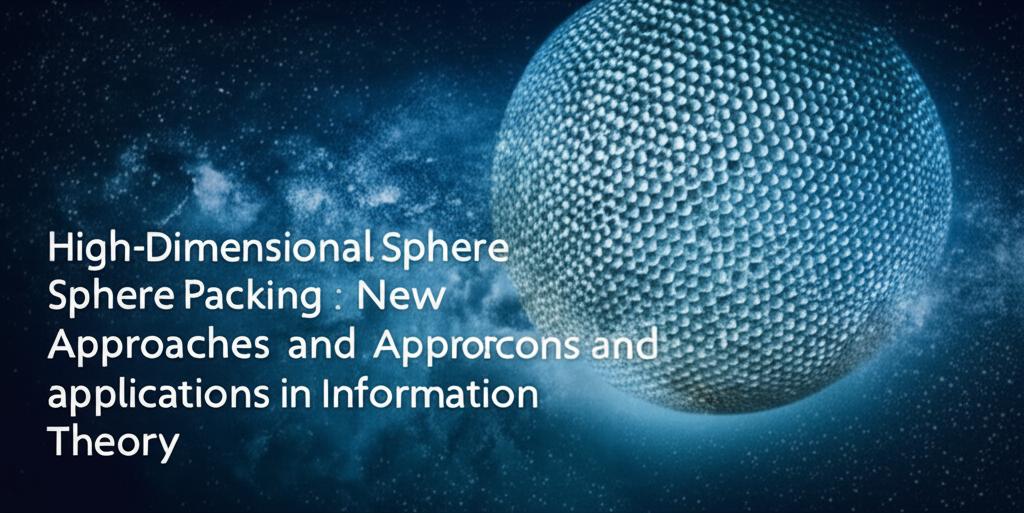The problem of how to pack identical spheres into a given space as densely as possible, known as sphere packing, has intrigued mathematicians for centuries. While the concept is easy to grasp in our familiar three dimensions, it becomes significantly more complex and fascinating in higher dimensions. Recent breakthroughs have not only pushed the boundaries of our understanding in these abstract realms but have also highlighted profound connections to information theory, particularly in the development of more robust error-correcting codes.
New Mathematical Frontiers in High DimensionsFor a long time, the densest sphere packings were only known for dimensions 1, 2, and 3. The three-dimensional case, famously conjectured by Johannes Kepler in 1611 and proven by Thomas Hales in 2017, established that the familiar "cannonball stack" or face-centered cubic lattice is the optimal arrangement, occupying approximately 74.05% of the space.
A major leap forward occurred in 2016 when Ukrainian mathematician Maryna Viazovska solved the sphere packing problem for 8 dimensions. She demonstrated that the E8 lattice provides the densest packing in this space. Shortly thereafter, Viazovska, in collaboration with other mathematicians, extended this success to 24 dimensions, proving the Leech lattice to be optimal. These solutions were revolutionary, employing novel mathematical tools, including modular forms, that were previously not standard in the study of sphere packing.
Despite these landmark achievements, the problem remains unsolved for most other dimensions. Mathematicians often rely on "bounds" – upper and lower limits – to estimate the optimal packing density in these higher-dimensional spaces. Recent research has focused on improving these bounds. Notably, a 2024 paper by Dr. Matthew Jenssen and collaborators announced the largest improvement to the lower bound of sphere packing in high dimensions since 1947. Their approach utilized random methods to find unstructured sphere packings, departing from the traditional focus on highly structured lattices. They established that sphere packings exist with a density of approximately d log(d) / 2(d+1), where d is the dimension. This finding aligns with predictions made by Nobel laureate Giorgio Parisi and Francesco Zamponi regarding the density of unstructured packings.
Other recent work has explored different mathematical techniques. For instance, some mathematicians are using graph theory to analyze and construct highly disordered packings. Another approach involves stochastic processes to construct ellipsoids that contain no lattice points in their interior but many on their boundary, aiming to find denser lattice packings. The "relaxed-reflect-reflect" (RRR) algorithm, originally from imaging applications, has also been applied to sphere packing, showing promise in improving density estimates in various dimensions.
Applications in Information Theory: Error-Correcting CodesThe abstract mathematical pursuit of high-dimensional sphere packing has surprisingly practical applications, particularly in information theory and the development of error-correcting codes. These codes are essential for reliable data transmission in technologies we use daily, such as mobile phones, Wi-Fi, and even space communication (like the Voyager probes).
When information is sent over a communication channel (e.g., a phone line or wireless signal), it is susceptible to "noise" or interference, which can corrupt the data. Error-correcting codes provide a way to encode information so that the original message can be recovered even if some errors occur during transmission.
The connection to sphere packing lies in representing messages as points in a high-dimensional space. Each point can be thought of as the center of a "sphere." The goal is to arrange these "message spheres" as densely as possible without them overlapping. If an error occurs during transmission, the received message might be slightly different from the original, but if the spheres are packed efficiently, the corrupted message will still fall within the "sphere" of the intended original message. This allows the receiver to correctly decode the message. The denser the packing, the more distinct messages (or "codewords") can be reliably distinguished within a given space, leading to more efficient and robust communication.
The optimal sphere packings in dimensions 8 (E8 lattice) and 24 (Leech lattice) have direct implications for constructing highly efficient error-correcting codes in those specific dimensionalities. While finding optimal packings in all high dimensions remains an open challenge, the ongoing mathematical advancements and the new approaches being developed continue to offer insights that could lead to improved coding schemes. Even approximations and improved bounds on sphere packing densities can guide engineers in designing better communication systems.
Challenges and Future DirectionsDespite recent progress, the sphere packing problem in general high dimensions is far from solved. Our intuition, largely based on three-dimensional experience, often fails in higher-dimensional spaces, where the geometry behaves very differently. For instance, the gaps between spheres can become surprisingly large as dimensions increase.
Key open questions include whether the densest packings in most high dimensions are ordered (lattice-like) or disordered (amorphous). Current research explores both possibilities. While lattice structures have yielded optimal solutions in specific dimensions (1, 2, 3, 8, and 24), new methods focusing on random or disordered packings are providing better lower bounds for density in general high dimensions.
The ongoing exploration of new mathematical techniques, including those leveraging graph theory, stochastic processes, and tools from other areas like physics and computer science, promises to shed further light on this enduring problem. The interplay between pure mathematical curiosity and the drive for practical applications in fields like information theory continues to fuel innovation in the fascinating world of high-dimensional sphere packing.

